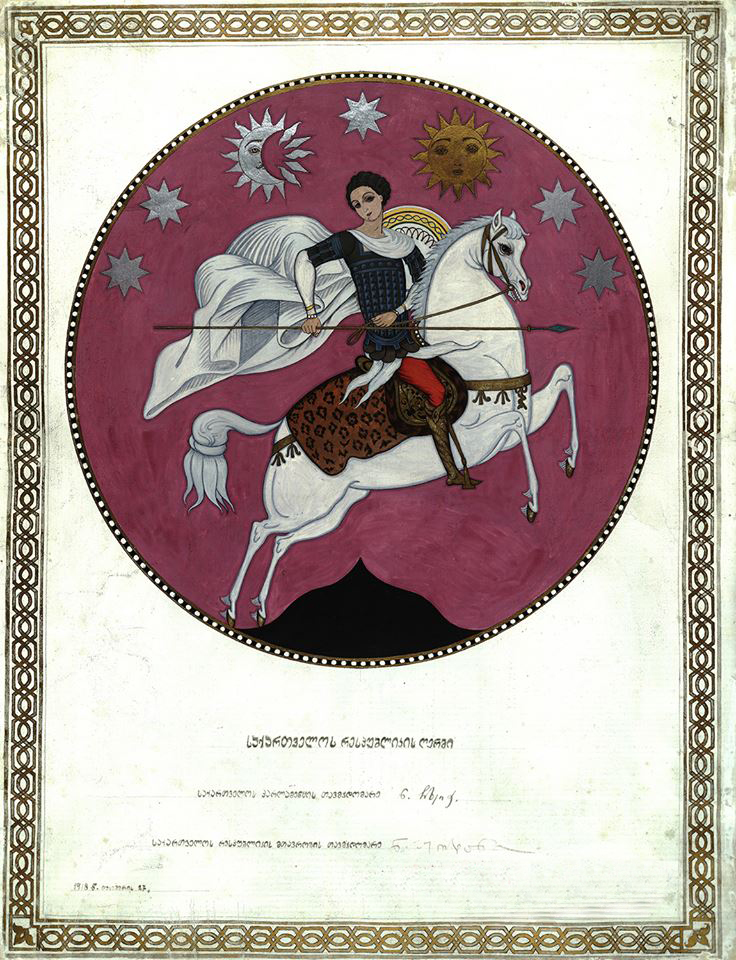Tetri Giorgi on:
[Wikipedia]
[Google]
[Amazon]

 Tetri Giorgi ( ka, თეთრი გიორგი, "White George") is one of the local names of Christian
Tetri Giorgi ( ka, თეთრი გიორგი, "White George") is one of the local names of Christian

 Tetri Giorgi ( ka, თეთრი გიორგი, "White George") is one of the local names of Christian
Tetri Giorgi ( ka, თეთრი გიორგი, "White George") is one of the local names of Christian Saint George
Saint George (Greek: Γεώργιος (Geórgios), Latin: Georgius, Arabic: القديس جرجس; died 23 April 303), also George of Lydda, was a Christian who is venerated as a saint in Christianity. According to tradition he was a soldie ...
in Georgia
Georgia most commonly refers to:
* Georgia (country), a country in the Caucasus region of Eurasia
* Georgia (U.S. state), a state in the Southeast United States
Georgia may also refer to:
Places
Historical states and entities
* Related to the ...
, specifically in the country's northeastern highland districts.
Tetri Giorgi was used as a national symbol, as part of Georgia's coat of arms in the years 1918-1921 and 1991–2004.
The name of Tetri Giorgi has also been adopted by several political and non-political organizations, significantly by an anti-Soviet
Anti-Sovietism, anti-Soviet sentiment, called by Soviet authorities ''antisovetchina'' (russian: антисоветчина), refers to persons and activities actually or allegedly aimed against the Soviet Union or government power within the ...
Georgian émigré group in Europe and a 1990s paramilitary unit.
History
Saint George
Saint George (Greek: Γεώργιος (Geórgios), Latin: Georgius, Arabic: القديس جرجس; died 23 April 303), also George of Lydda, was a Christian who is venerated as a saint in Christianity. According to tradition he was a soldie ...
was venerated in Georgia since Late Antiquity.
The exonym ''Georgia'' was applied to the country from the 11th or 12th century,
probably by false etymology, but inspired by the great popularity of the saint there.
The cult of ''Tetri Giorgi'' is associated with the Kakheti region in particular.
It is syncretistic, combining the Christian saint with the cult of a local lunar deity.
A feast day of Tetri Giorgi (''tetrigiorgoba'') separate from the feast day of the Christian saint was once marked annually on 14 August, when many pilgrims from the eastern Georgian provinces attended an overnight feast at the saint's chief shrine – a 14th-century church overlooking the village Atsquri in what is now Akhmeta Municipality
Akhmeta ( ka, ახმეტის მუნიციპალიტეტი, ''Axmeṫis municiṗaliṫeṫi'') is the administrative – territorial unit in Eastern Georgia, in the region of Kakheti. The administrative center of Akhmeta muni ...
, Kakheti.
In heraldry
In May 1918, theDemocratic Republic of Georgia
The Democratic Republic of Georgia (DRG; ka, საქართველოს დემოკრატიული რესპუბლიკა ') was the first modern establishment of a republic of Georgia, which existed from May 1918 to F ...
– newly independent from the Russian Empire
The Russian Empire was an empire and the final period of the Russian monarchy from 1721 to 1917, ruling across large parts of Eurasia. It succeeded the Tsardom of Russia following the Treaty of Nystad, which ended the Great Northern War. ...
– chose the equestrian depiction of Tetri Giorgi as a centerpiece of its coat of arms
A coat of arms is a heraldic visual design on an escutcheon (i.e., shield), surcoat, or tabard (the latter two being outer garments). The coat of arms on an escutcheon forms the central element of the full heraldic achievement, which in its ...
. But the image was rendered more secular as its Christian symbolism was disfavored by Georgia's Social-Democratic government, recalls Revaz Gabashvili Revaz Gabashvili ( ka, რევაზ გაბაშვილი; November 6, 1882 – 1969) was a Georgian politician and writer involved in the independence movement and revolutionary journalism in the early 20th century.
Gabashvili was born o ...
, a critic of the contemporary Georgian government. Gabashvili, Revaz, "მოგონებები" ("Memoirs"), pp. 119-120, in: Sharadze, Guram & Sanikidze, Levan (ed., 1992), დაბრუნება (ქართული ემიგრანტული ლიტ-რა) ("The Comeback — Georgian Émigré Literature"). Tbilisi: Metsniereba.
In this design, Tetri Giorgi is shown as an armed horseman below a depiction of "the Seven Celestials" (the seven classical planets
In classical antiquity, the seven classical planets or seven luminaries are the seven moving astronomical objects in the sky visible to the naked eye: the Moon, Mercury, Venus, the Sun, Mars, Jupiter, and Saturn. The word ''planet'' comes from ...
).
This coat of arms was in use until the Soviet takeover in 1921 and again in post-Soviet Georgia from 1991 to 2004.
See also
*Tetri Giorgi (organization) The Patriotic Union Tetri Giorgi ( ka, ეროვნული ერთობის დარაზმულობა "თეთრი გიორგი" ''erovnuli ertobis darazmuloba "tetri giorgi"'') was the Georgian national political, anti- ...
*Armazi (god)
According to the medieval ''Georgian Chronicles'', Armazi ( ka, არმაზი) was the supreme deity in the pantheon of pre-Christian Caucasian Iberia.
Iberian Armazi and Hittite-Luwian Arma/Armaziti
Georgian literary tradition credits ...
* Kopala
*Uastyrdzhi
Nykhas Uastyrdzhi ( os, Ныхас Уастырджи, ) is the name of Saint George in Ossetian folklore. Uastyrdzhi is the patron of the male sex and travellers as well as being a guarantor of oaths, like his Iranian counterpart Mithra wit ...
* Saint George and the Dragon
References
History of Georgia (country) National symbols of Georgia (country) Religion in Georgia (country) Georgian words and phrases {{Georgia-hist-stub